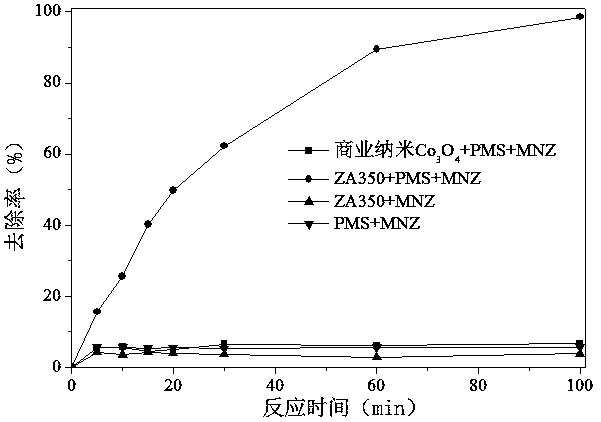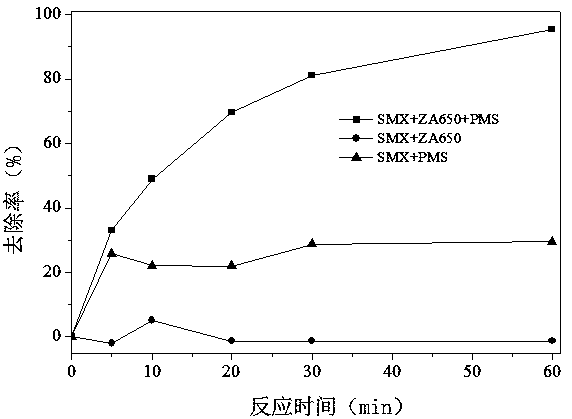Method for generating reactive oxygen species by using Co-MOF-based macroscopic composite material to remove emerging contaminants
A composite material and macrobody technology, applied in the field of Co-MOFs-based macrobody composite materials to generate active oxygen species to remove emerging pollutants, can solve the problem of high cost of reuse
- Summary
- Abstract
- Description
- Claims
- Application Information
AI Technical Summary
Problems solved by technology
Method used
Image
Examples
Embodiment 1
[0020] A method for removing emerging pollutants (ECs) using Co-MOFs-based macroscopic bulk composites to generate reactive oxygen species (ROS) includes the following steps.
[0021] (1) Preparation of Co-MOFs-based macroscopic composites: a) 480 mM 2-methylimidazole methanol solution (first impregnation solution) and 60 mM cobalt nitrate methanol solution (second impregnation solution); b ) Put 60 g of spherical activated alumina (3~5mm) in the first soaking solution and soak for 30 minutes, remove it, and wash it with methanol for 3 times; c) Put the product obtained in step b) in the second soaking solution Take it out after soaking for 30 minutes, and wash it with methanol for 3 times; d) Put the product obtained in step c) in the mixed solution of the first soaking solution and the second soaking solution and soak it for at least 24 hours, then take it out, wash it with methanol and deionized water for 5 times each, and then dried at 105°C; e) Under aerobic conditions, t...
Embodiment 2
[0025] (1) To investigate the efficiency of Co-MOFs-based macroscopic composites to activate PMS to remove SMX from water: Measure 80 mL of SMX aqueous solution with a concentration of 10 mg / L in a clean reaction bottle, add ZA650 (20 g / L) and PMS (0.25 mM ), placed at room temperature (25±2°C) and stirred (300 rpm) for 60 min, and samples were taken at regular intervals for analysis.
[0026] (3) Draw the obtained data into a graph, such as image 3 It is shown that the ZA650 / PMS system can oxidize and remove more than 95% of SMX within 60 min; in addition, it can be seen from the figure that the adsorption of SMX by ZA650 or the oxidation of SMX by PMS alone is not the main reason for its removal during the entire reaction cycle. The removal of SMX was mainly achieved by the activation of PMS by ZA650 to generate reactive oxygen species.
Embodiment 3
[0028] (1) To investigate the efficiency of Co-MOFs-based macroscopic composites to activate PMS to remove resistant bacteria in water: Measure 80 mL of E. coli (carrying tetracycline resistance gene) aqueous solution with a concentration of 107 cfu / mL in a clean reaction bottle, add ZA450 (20 g / L) and PMS (1 mM), placed at room temperature (25 ± 2°C) and stirred (300 rpm) for 45 min, and samples were taken at regular intervals for analysis; the results showed that within 45 min, the ZA650 / PMS system could Completely remove tetracycline-resistant E. coli (and cannot be cultured after inactivation), while the removal of target resistant bacteria is less than 2.5log when ZA450 and PMS exist alone throughout the reaction cycle, and the removal of target resistant bacteria is mainly due to the activation of ZA450 PMS produces ROS due to the rapid destruction of its cellular structure and resistance genes.
PUM
 Login to View More
Login to View More Abstract
Description
Claims
Application Information
 Login to View More
Login to View More - Generate Ideas
- Intellectual Property
- Life Sciences
- Materials
- Tech Scout
- Unparalleled Data Quality
- Higher Quality Content
- 60% Fewer Hallucinations
Browse by: Latest US Patents, China's latest patents, Technical Efficacy Thesaurus, Application Domain, Technology Topic, Popular Technical Reports.
© 2025 PatSnap. All rights reserved.Legal|Privacy policy|Modern Slavery Act Transparency Statement|Sitemap|About US| Contact US: help@patsnap.com



